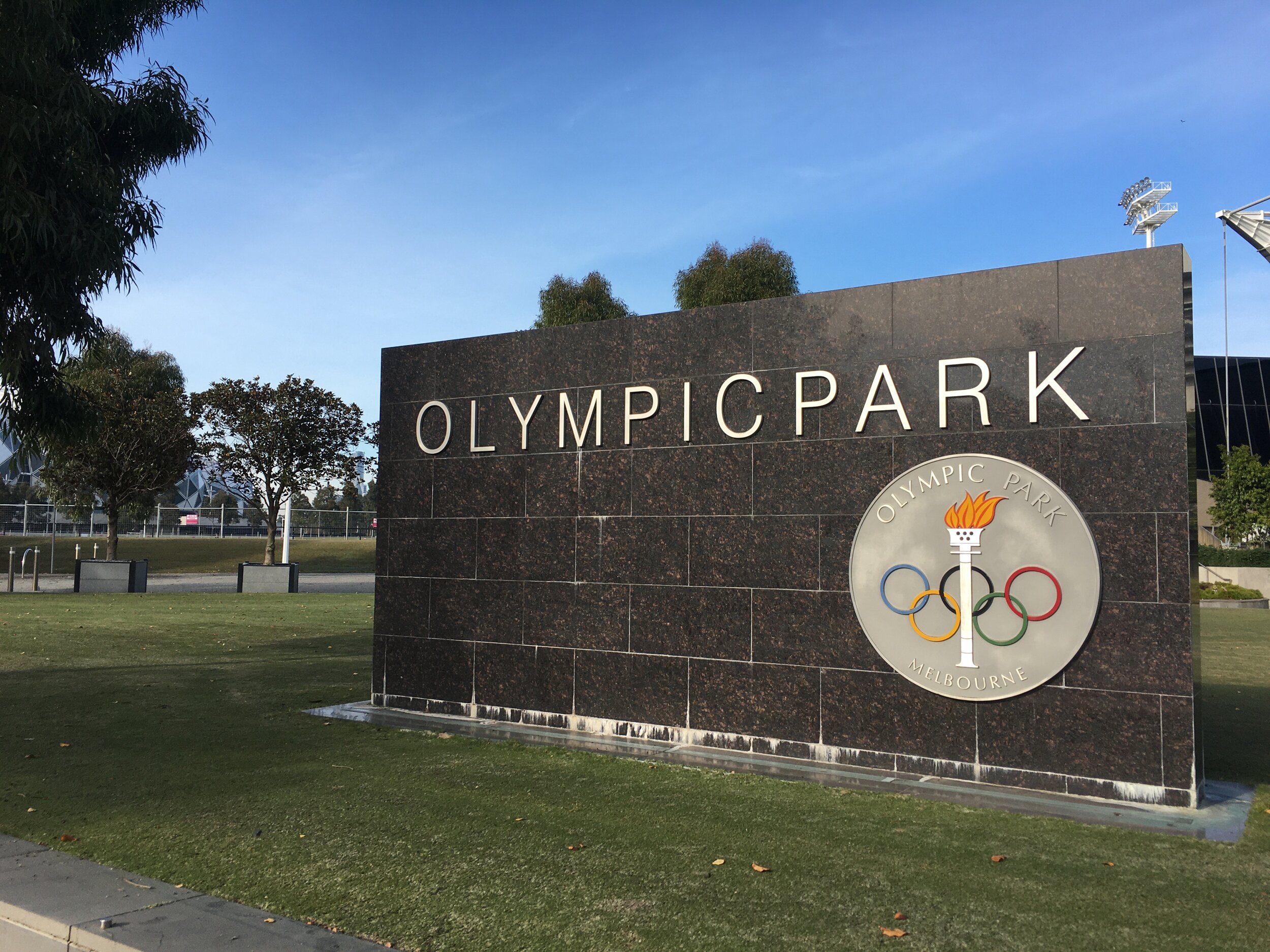Known as “Sportsmanship” this statue located at Olympic Park on Olympic Boulevard and created by Mitch Mitchell in 2002, captures a moment of pure sportsmanship, where one runner stops to help another who has fallen.
The runners in question are John Landy and the then relatively-unknown Ron Clarke. The race was held at Olympic Park Melbourne, in front of a 22,000 strong crowd and was the final of the National Championships, a pre-cursor to the Olympic Games to be held later that year.
John Landy was the second person to achieve to sub-4 minute mile and at the time held the World Record for the fastest mile, at 3 minutes and 58 seconds. There was a lot of expectation on Landy to set a new world record in this race. What happened next is best described by the lad depicted here on the ground, Ron Clarke – who at the time of the race was the World Junior Champion. Below is an excerpt from his autobiography, The Unforgiving Minute, as only he can best describe what happened:
“For two and a half laps the crowd watched enthralled. Robbie Morgan-Morris went through the first lap in 59 seconds followed closely by myself, Alec Henderson, John Plummer and the favourite [Landy]. At the half-mile Robbie was still there and the time was 2:02:0. I loped along behind him, anxious to finish at least among the first three runners and improve my best mile time. Soon after the third lap I took the lead and then on a bend occurred an incident that stunned everybody... Alec came up on the inside of John. He evidently tried also to wedge his way through between me and the kerb, and in doing so accidentally clipped my heel. I lost balance and went sprawling on to the track while Alec staggered on to the verge of the arena, recovered and ran on. John had no other choice but to jump over me, his spikes lacerating my right arm as he did so. I was in such a daze that I felt no pain. Within seconds the whole field was jumping over me or running wide. Then John did a foolish, but typically thoughtful thing - he came back to say he was sorry and see if I was alright. The mile title, his bid for the world record, even the approaching Olympics... all were forgotten as the champion made his spontaneous gesture to the raw stripling floundering in the cinders.”
More than 60 years later this spontaneous gesture has never been forgotten. Let’s also not forget, that despite losing 6 or 7 seconds by stopping to help, Landy made up a huge deficit during the final two laps to go on to win that race in the time of 4 minutes and 4 seconds.
Both gentlemen went on to appear at the Olympic Games later that year. Melbourne boy, Ron Clarke then only 19, was chosen to light the Olympic Flame during the opening ceremony but did not compete.
Also born and bred in Melbourne, John Landy did compete at his local Olympic Games. Sadly, he sustained an injury during promotions in the USA so was not running at 100 per cent at the 1956 Games in Melbourne but still took home the Bronze medal in the 1500 metre (or 1 mile) race.
What became of the two of them?
Ron Clarke, the son and brother of two Essendon Football Club players, eventually moved to Queensland’s Gold Coast in 1995. A trained Accountant, he went on to become Mayor of the Gold Coast in 2004, retiring from the position 2012. He passed away from kidney failure in 2015 and is survived by his wife and two sons after losing his daughter to breast cancer in 2009. His influence helped to establish a second Queensland based AFL team, the Gold Coast Suns. During his athletic career, spanning more than a decade and various distances between 1 to 6 miles, Ron Clarke won 12 Australian Championships and 12 Victorian Championships. He brought home a Bronze medal in the 10,000 metre at the 1964 Tokyo Olympics and 4 Silver medals from 3 Commonwealth Games (Perth 1962, Kingston 1966 and Edinburgh 1970). A 44-day tour of Europe in 1965 saw him compete 18 times and break 12 World Records including the first man to run 3 miles (4,828 metres) in under 13 minutes (12.52.4) and was the first to run 10,000 metres (6.214 miles) in less than 28 minutes (27.39.4).
John Landy studied Agricultural Science at University. Following his retirement from athletics, he wrote two natural history books (Close to Nature, 1984 and A Coastal Diary, 1993). He served for eight years on the Victorian Land Conservation Council (1971-1978). In January 2001 Landy was sworn in as Governor of Victoria, a successful post he held for more than 5 years, retiring in 2006. During the final months of his Governorship Landy was also the final baton runner at the 2006 Commonwealth Games, presenting the baton to her majesty The Queen at the Opening Ceremony which was held at the Melbourne Cricket Ground. Landy, now aged 90, resides in the former gold mining Victorian town of Castlemaine with his wife Lynne. He has a son and a daughter, both of whom live overseas with their families.











